Designing the Learning Experiences in Serious Games: The Overt and the Subtle—The Virtual Clinic Learning Environment
Abstract
1. Introduction
2. Virtual Clinic Learning Environment (VCLE) Framework
2.1. Attributes of Serious Games and Instructional Design
- Does learning feel like play?
- Are the experiences interconnected?
- Does the player learn by doing?
- Is failure reframed as iteration?
- Is feedback immediate and ongoing?
- Is the challenge constant and consistent?
2.2. VCLE Conceptual Description
2.3. VCLE Technical Overview
3. Serious Game as Adjustable Learning Scaffold and the Overt Learning Experience
- <Consult Instructor> What should we do first? “Ask your patient an open-ended question.”
- How are you today, what can I help you with? “I’m having trouble swallowing.”
- What do you want? “My throat hurts. Is there a problem?”
- The case should be meaningful and present the problem clearly.
- The distractors/alternatives should be plausible and should be homogenous.
- All options should be of similar lengths.
- The use of negative questions should be avoided.
- Embedding clues to the correct response within the question choices and the responses should be avoided.
- Wrong answers need to be in a proportionate number to the correct answers.
4. Sense of Place from the Virtual: The Subtle Learning Experience
5. Methods
5.1. Deploying the Virtual Clinic Learning Environment to a New Audience
5.2. User Experience Survey
6. Results and Discussions
7. Conclusions and Next Steps
Author Contributions
Funding
Acknowledgments
Conflicts of Interest
References
- Rosseter, R. Fact Sheet: Nursing Shortage. American Association of Colleges of Nursing, the Voice of Academic Nursing, 2017. Available online: http://www.aacnnursing.org/Portals/42/News/Factsheets/Nursing-Shortage-Factsheet-2017.pdf (accessed on 17 June 2018).
- Johnson, J. Differences in the performance of baccalaureate, associate degree and diploma nurses: A meta-analysis. Res. Nurs. Health 1988, 11, 183–197. [Google Scholar] [CrossRef] [PubMed]
- Taglieri, C.A.; Crosby, S.J.; Zimmerman, K.; Schneider, T.; Patel, D.K. Evaluation of the Use of a Virtual Patient on Student Competence and Confidence in Performing Simulated Clinic Visits. Am. J. Pharm. Educ. 2017, 81, 87. [Google Scholar] [PubMed]
- Anton, D.; Berges, I.; Bermudez, J.; Goni, A.; Illarramendi, A. A Telerehabilitation System for the Selection, Evaluation and Remote Management of Therapies. Sensors 2018, 18, 1459. [Google Scholar] [CrossRef] [PubMed]
- Peery, J. Questions for Serious Game Development for Success. In Proceedings of the 2016 IEEE International Conference on Serious Games and Applications for Health (SeGAH), Orlando, FL, USA, 11–13 May 2016; pp. 1–4. Available online: https://www.computer.org/csdl/proceedings/segah/2016/2210/00/07586227-abs.html (accessed on 20 May 2018).
- Smith, M.A.; Mohammad, R.A.; Benedict, N. Use of Virtual Patients in an Advanced Therapeutics Pharmacy Course to Promote Active, Patient-Centered Learning. Am. J. Pharm. Educ. 2014, 78, 125. [Google Scholar] [CrossRef] [PubMed]
- Bloom, B.S. Learning for Mastery, Instruction and Curriculum. Eval. Comment 1968, 1, 1–12. [Google Scholar]
- Grossard, C.; Grynspan, O.; Serret, S.; Jouen, A.; Bailly, K.; Cohen, D. Serious Games to Teach Social Interactions and Emotions to Individuals with Autism Spectrum Disorders (ASD). Comput. Educ. J. 2017, 113, 195–211. [Google Scholar] [CrossRef]
- Torres, F.; Tovar, L.A.N.; del Rio, M.S. A Learning Evaluation for an Immersive Virtual Laboratory for Technical Training Applied into a Welding Workshop. EURASIA J. Math. Sci. Technol. Educ. 2017, 13, 521–532. [Google Scholar] [CrossRef]
- White, S.; Prachyabrued, M.; Chambers, T.; Borst, C.W.; Reiners, D. Low-Cost Simulated MIG Welding for Advancement in Technical Training. Virtual Real. 2011, 15, 69–81. [Google Scholar] [CrossRef]
- Nee, A.Y.C.; Ong, S.K. Virtual and Augmented Reality Applications in Manufacturing. In Proceedings of the 7th IFAC Conference on Manufacturing Modelling, Management and Control, International Federation of Automatic Control, Saint Petersburg, Russia, 19–21 June 2013; pp. 15–26. [Google Scholar]
- Dickey, M. Report: Evaluation of the Virtual Clinic. Unpublished Report to ECU CoN. 2016. [Google Scholar]
- Kelley, C.G. Using a Virtual Patient in an Advanced Assessment Course. J. Nurs. Educ. 2015, 54, 228–231. [Google Scholar] [CrossRef] [PubMed]
- Relph, E. Spirit of Place and Sense of Place in Virtual Realities. Technè Res. Philos. Technol. 2007, 10, 17–25. [Google Scholar] [CrossRef]
- Ciolfi, L.; Bannon, L.J. Space, Place and the Design of Technologically Enhanced Physical Environments. In Space, Spatiality and Technology; Turner, P., Davenport, E., Eds.; Springer: Dordrecht, The Netherlands, 2005; pp. 217–232. ISBN 1402032722. [Google Scholar]
- Arora, V.; Khazanchi, D. Sense of Place in Virtual World Learning Environments: A Conceptual Exploration. In Proceedings of the Faculty Presentations on Department of Information Systems and Quantitative Analysis, University of Nebraska, Omaha, NE, USA, 21–22 May 2010; Digital Commons@UNO: Omaha, NE, USA, 2010. Available online: http://digitalcommons.unomaha.edu/isqafacproc/8 (accessed on 1 May 2018).
- Lippincott, J.K. Linking the Information Commons to Learning. In Learning Spaces; Oblinger, D.G., Ed.; Educause: Louisville, CO, USA, 2006; ISBN 0-9672853-7-2. [Google Scholar]
- Clark, S.; Maher, M.L. The Effects of a Sense of Place on the Learning Experience in a 3D Virtual World. In Proceedings of the 10th Association for Learning Technologies Conference on Communities of Practice, Sheffield, UK, 8–10 September 2003; Cook, J., McConnell, D., Eds.; pp. 82–101. [Google Scholar]
- Peck, M.S. Meditations from the Road; Simon and Schuster: New York, NY, USA, 1993; ISBN 0-671-79799-9. [Google Scholar]
- Hirose, M.; Takahashi, K.; Koshizuka, T.; Morinobu, T.; Watanabe, Y. An Alternate Way to Generate Virtual Worlds: A Study of Image Processing Technology for Synthetic Sensations. Presence Teleoper. Virtual Environ. 1996, 5, 61–71. [Google Scholar] [CrossRef]
- Dourish, P. Re-Place-ing Space: The Roles of Place and Space in Collaborative Systems. In Proceedings of the 20th Anniversary Conference on Computer Supported Cooperative Work, Banff, AB, Canada, 4–8 November 2006; ACM: New York, NY, USA, 2006; pp. 299–308. [Google Scholar]
- Huizinga, J. Homo Ludens: A Study of the Play Element in Culture; Beacon Press: Boston, MA, USA, 1955; ISBN 978-1-62138-999-6. [Google Scholar]
- Caillois, R. Man, Play, and Games; Free Press: New York, NY, USA, 1961; ISBN 0-252-07033-X. [Google Scholar]
- Iten, N.; Petko, D. Learning with Serious Games: Is Fun Playing the Game a Predictor of Learning Success? Br. J. Educ. Technol. 2016, 47, 151–163. [Google Scholar] [CrossRef]
- Anton, D.; Gregorij, K.; Bajcsy, R. User Experience and Interaction Performance in 2D/3D Telecollaboration. Future Gener. Comput. Syst. 2018, 82, 77–88. [Google Scholar] [CrossRef]

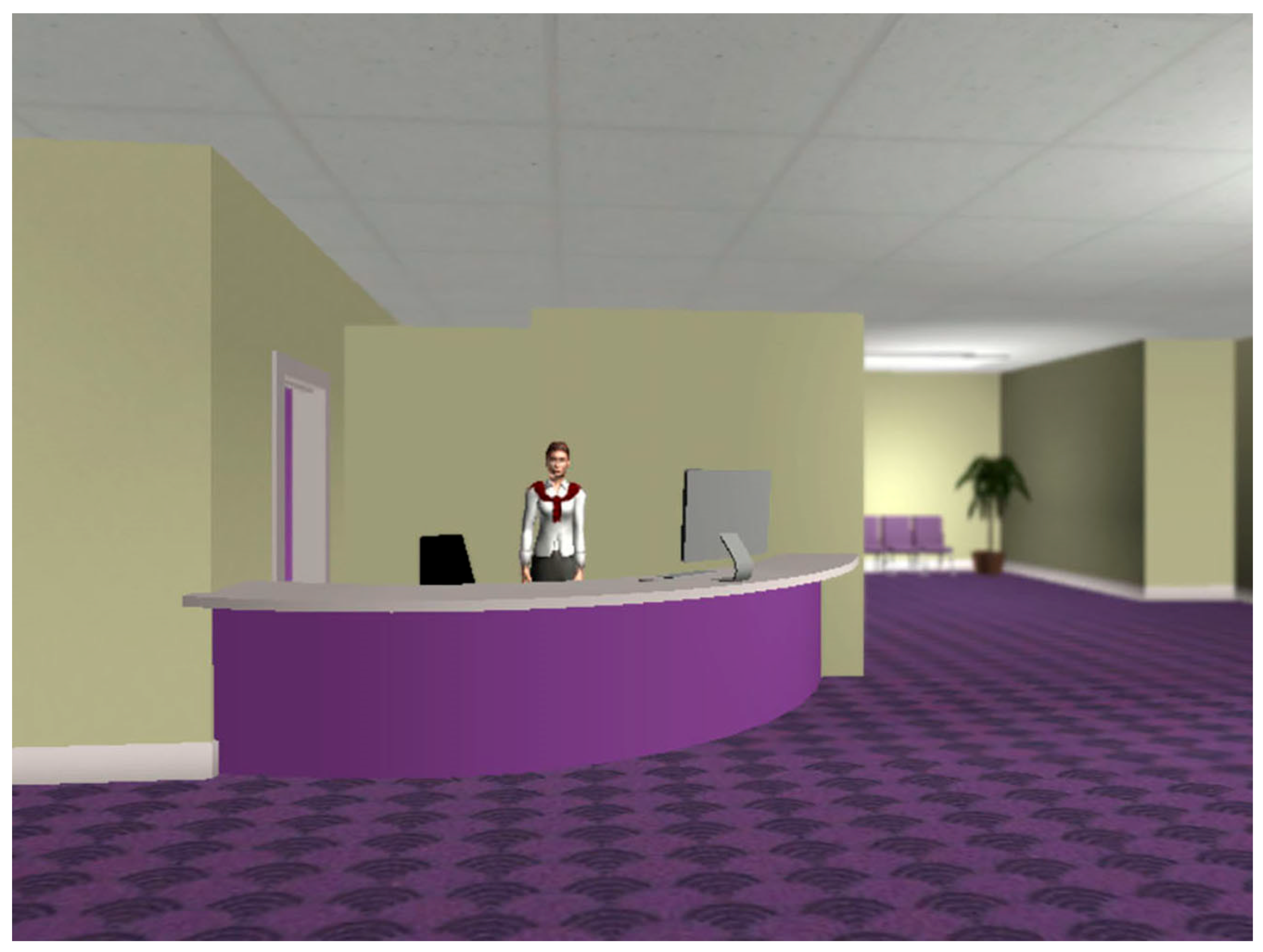
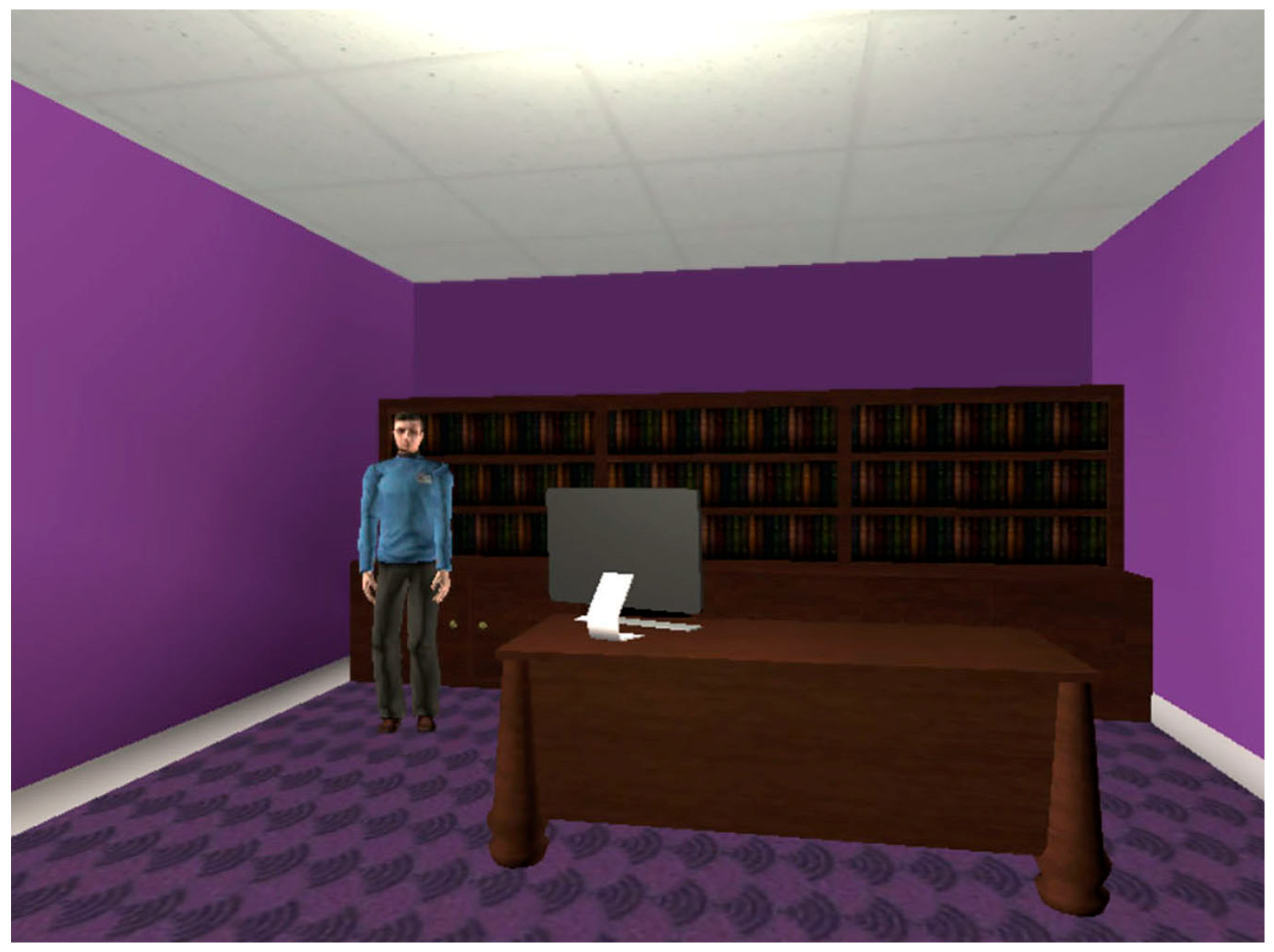
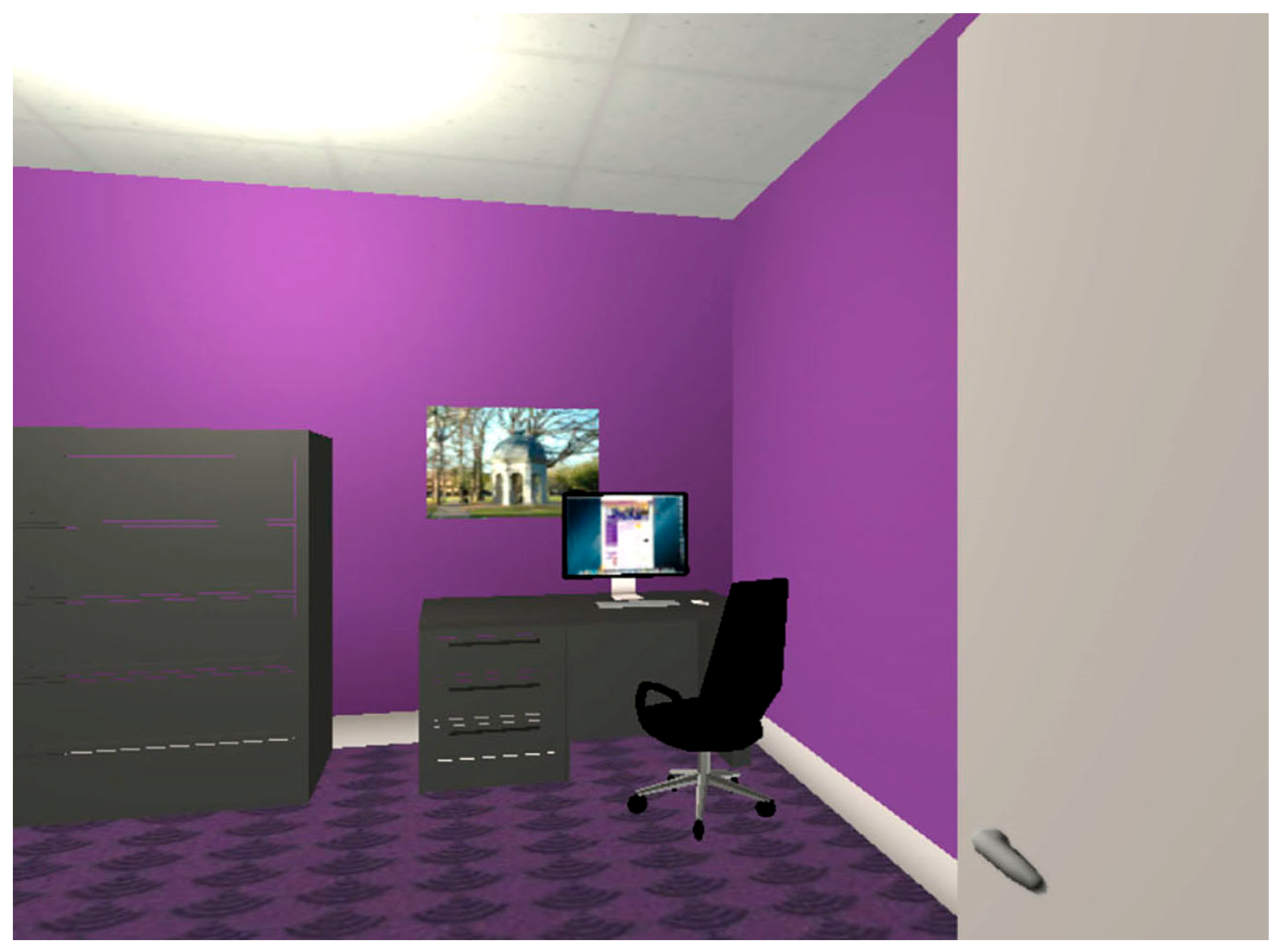
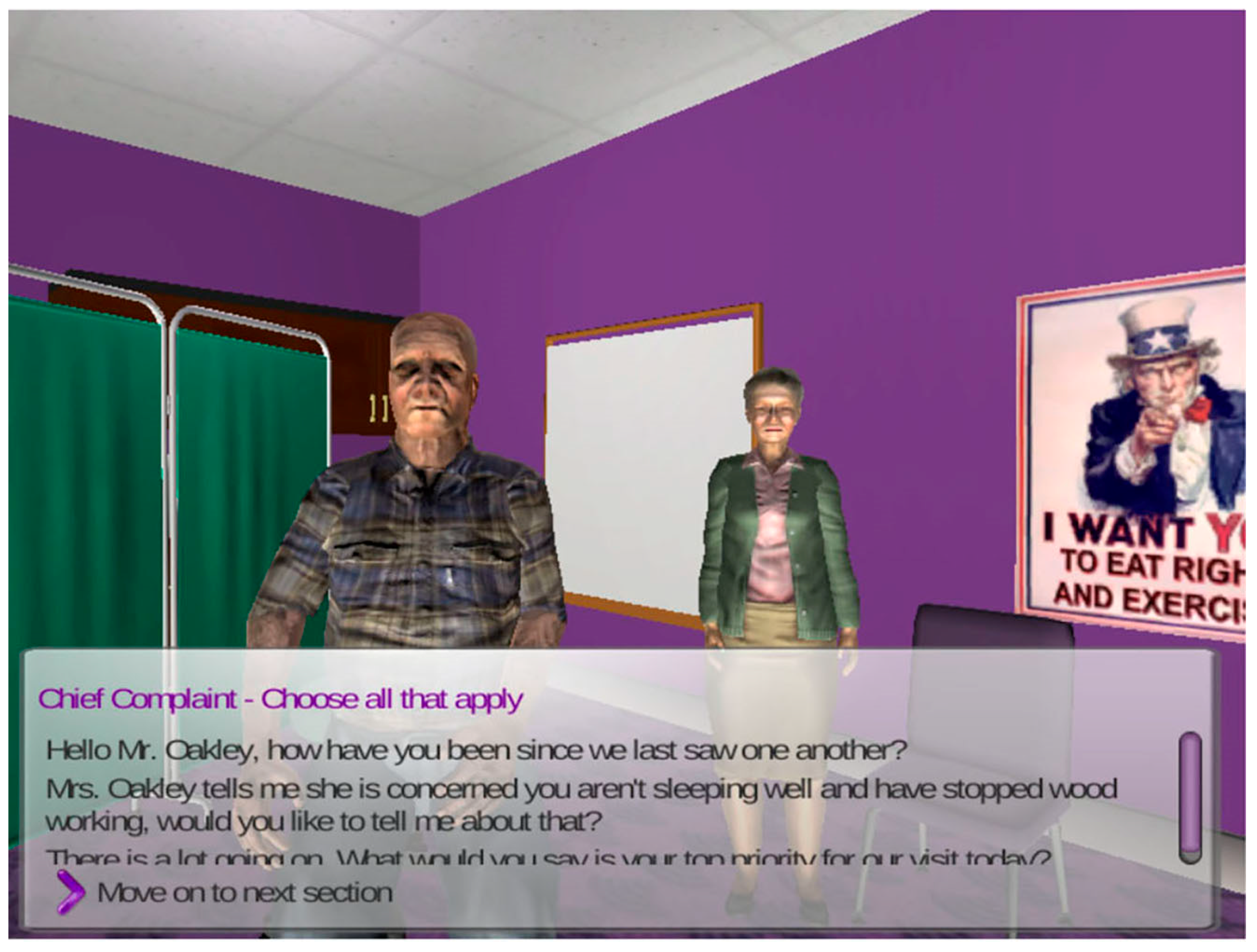
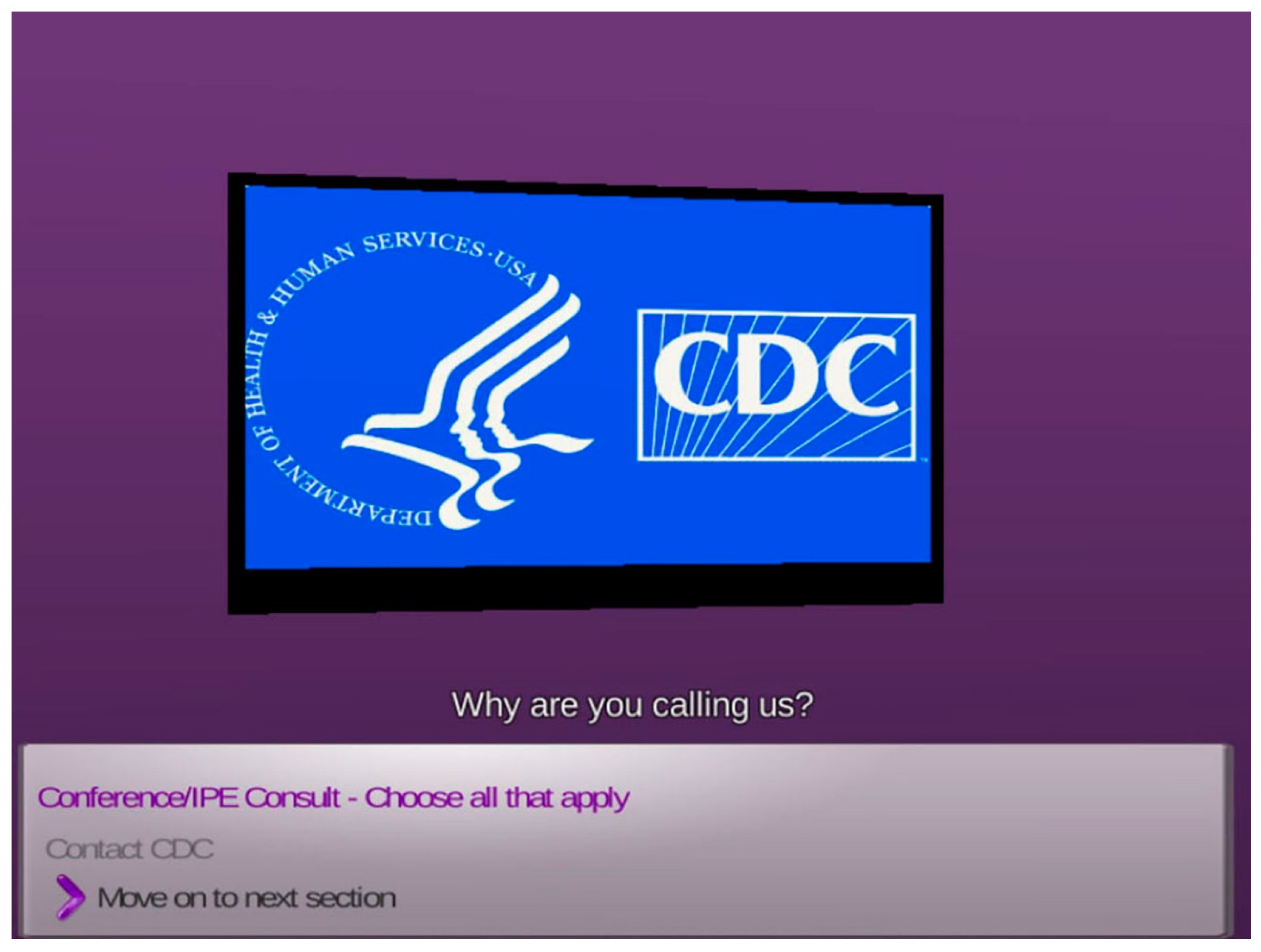
| Survey Question | Strongly Disagree/Disagree/Neutral | Agree | Strongly Agree | |||
|---|---|---|---|---|---|---|
| n | % | n | % | n | % | |
| Q1. There was enough information provided at the beginning of the simulation to provide direction. | 3 | 19 | 11 | 69 | 2 | 12 |
| Q2. I clearly understood the objectives of the Virtual Clinic Case. | 3 | 19 | 11 | 69 | 2 | 12 |
| Q3. The cues were appropriate to promote my understanding. | 2 | 12 | 11 | 69 | 3 | 19 |
| Q4. The simulation was designed for my specific level of knowledge and skills. | 5 | 31 | 6 | 37 | 5 | 31 |
| Q5. Feedback provided was constructive. | 0 | 0 | 9 | 56 | 7 | 44 |
| Q6. The scenario resembled a real-life situation. | 4 | 25 | 6 | 37 | 6 | 37 |
| Q7. I would like to use the Virtual Clinic in the future. | 2 | 12 | 10 | 62 | 4 | 25 |
| “The program is good, I liked the options, they are realistic responses.” |
| “Good learning example overall. It could come in handy over time especially to new nursing students that have never done any one-on-one care. The fact that it doesn’t take long is good as well.” |
| “I really enjoyed this activity. Being able to look up the answers as I did the activity helped me to concrete the information in my brain and really understand what I was learning.” |
| “I think it was a good learning experience. It reminds me of <commercially available software>, something we did in Health Assessment, last semester. It really puts things into a more realistic perspective.” |
| “This was a different experience that helped me look up information that was needed to help treat patients.” |
| “I really enjoyed having multiple choice answers. Also, I liked the realistic feel of being able to interview the patient.” |
| “I do not usually like virtual learning because the scenarios are really scripted and do not usually respond appropriately. This was not bad. I would like to see what other situations can be put in place.” |
| “This was much better than <commercially available software>.” |
| “The simulation is harder to start compared to <commercially available software>, however it moved through much faster and was more user friendly than <commercially available software>. |
| “This was an interesting learning experience, a lot like our <commercially available software>, but I liked this better. It was a lot less confusing than <commercially available software>, which made it more enjoyable.” |
| “I like this virtual clinical experience. I like that it gave you immediate feedback and let you know if the answers you put down were right or wrong. The virtual clinical experience was much easier to use and follow along.” |
© 2018 by the authors. Licensee MDPI, Basel, Switzerland. This article is an open access article distributed under the terms and conditions of the Creative Commons Attribution (CC BY) license (http://creativecommons.org/licenses/by/4.0/).
Share and Cite
Peery, J.G.; Pasalar, C. Designing the Learning Experiences in Serious Games: The Overt and the Subtle—The Virtual Clinic Learning Environment. Informatics 2018, 5, 30. https://doi.org/10.3390/informatics5030030
Peery JG, Pasalar C. Designing the Learning Experiences in Serious Games: The Overt and the Subtle—The Virtual Clinic Learning Environment. Informatics. 2018; 5(3):30. https://doi.org/10.3390/informatics5030030
Chicago/Turabian StylePeery, Joshua G., and Celen Pasalar. 2018. "Designing the Learning Experiences in Serious Games: The Overt and the Subtle—The Virtual Clinic Learning Environment" Informatics 5, no. 3: 30. https://doi.org/10.3390/informatics5030030
APA StylePeery, J. G., & Pasalar, C. (2018). Designing the Learning Experiences in Serious Games: The Overt and the Subtle—The Virtual Clinic Learning Environment. Informatics, 5(3), 30. https://doi.org/10.3390/informatics5030030





